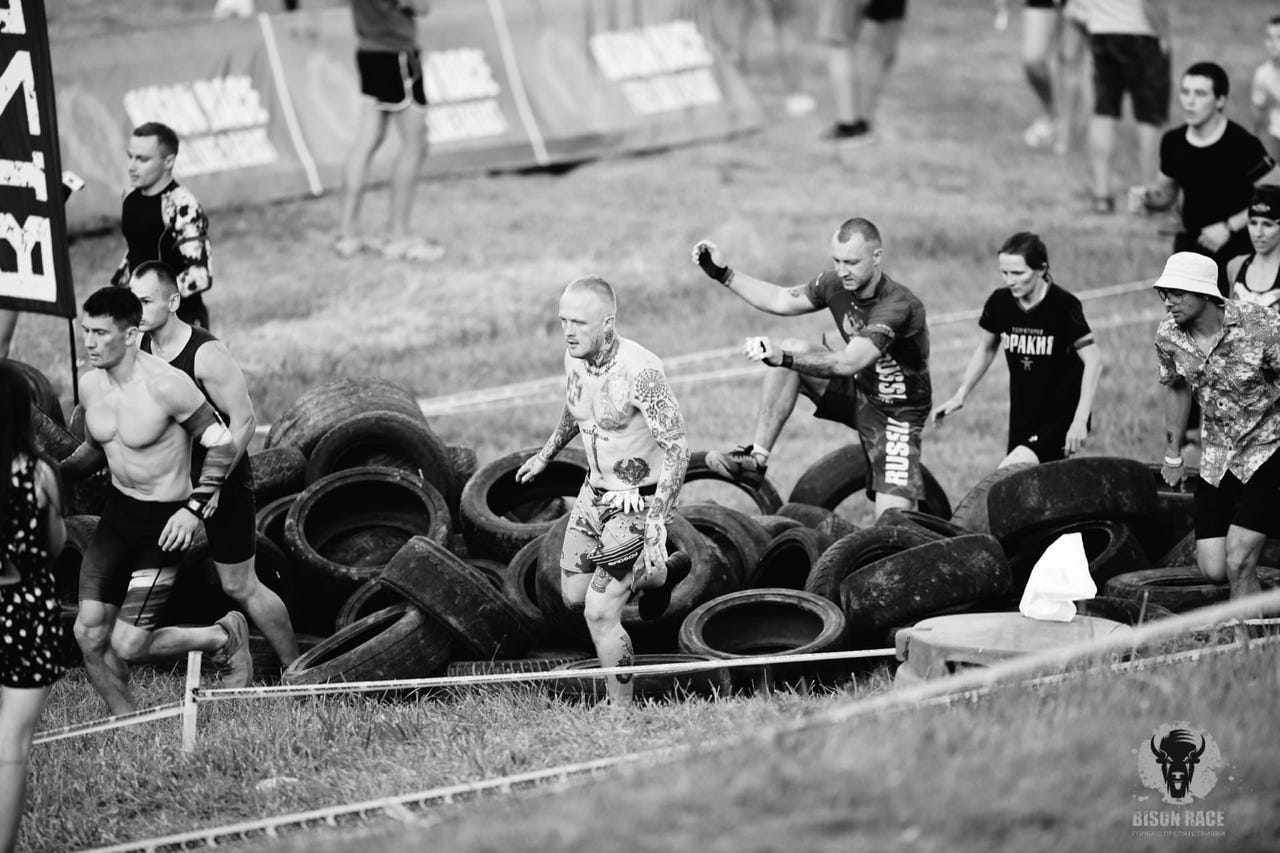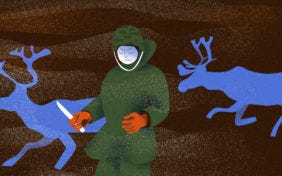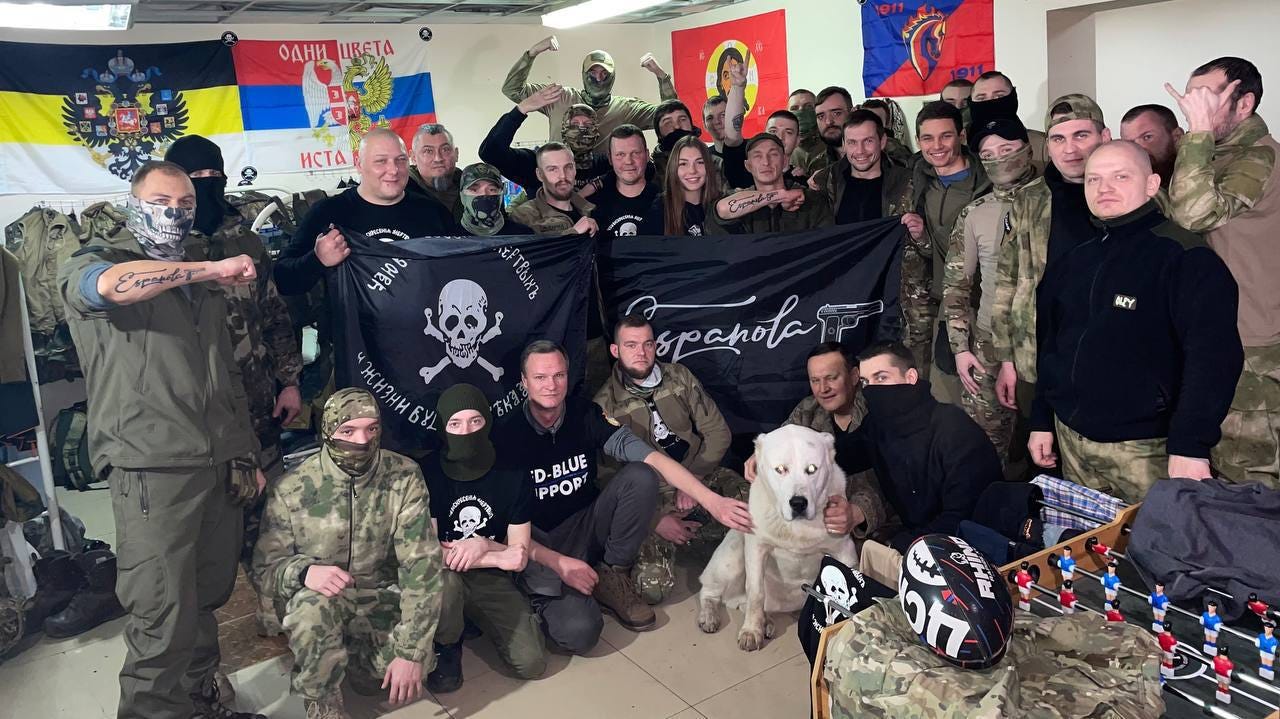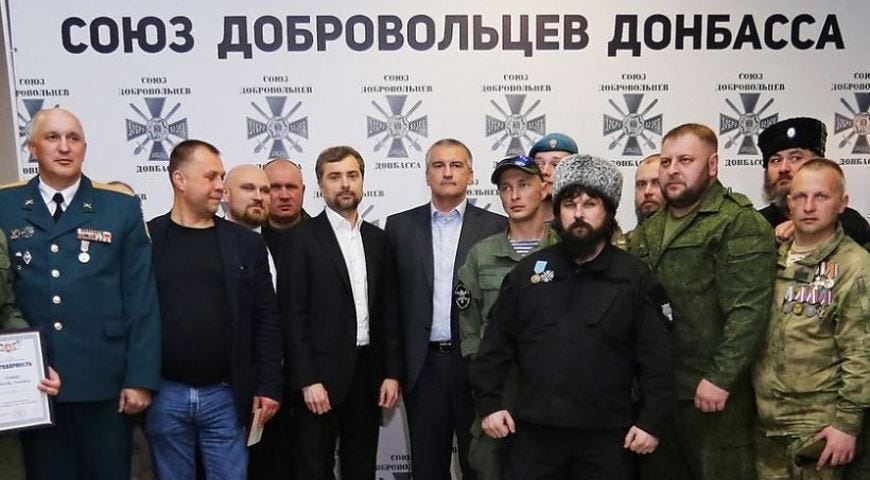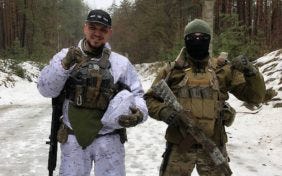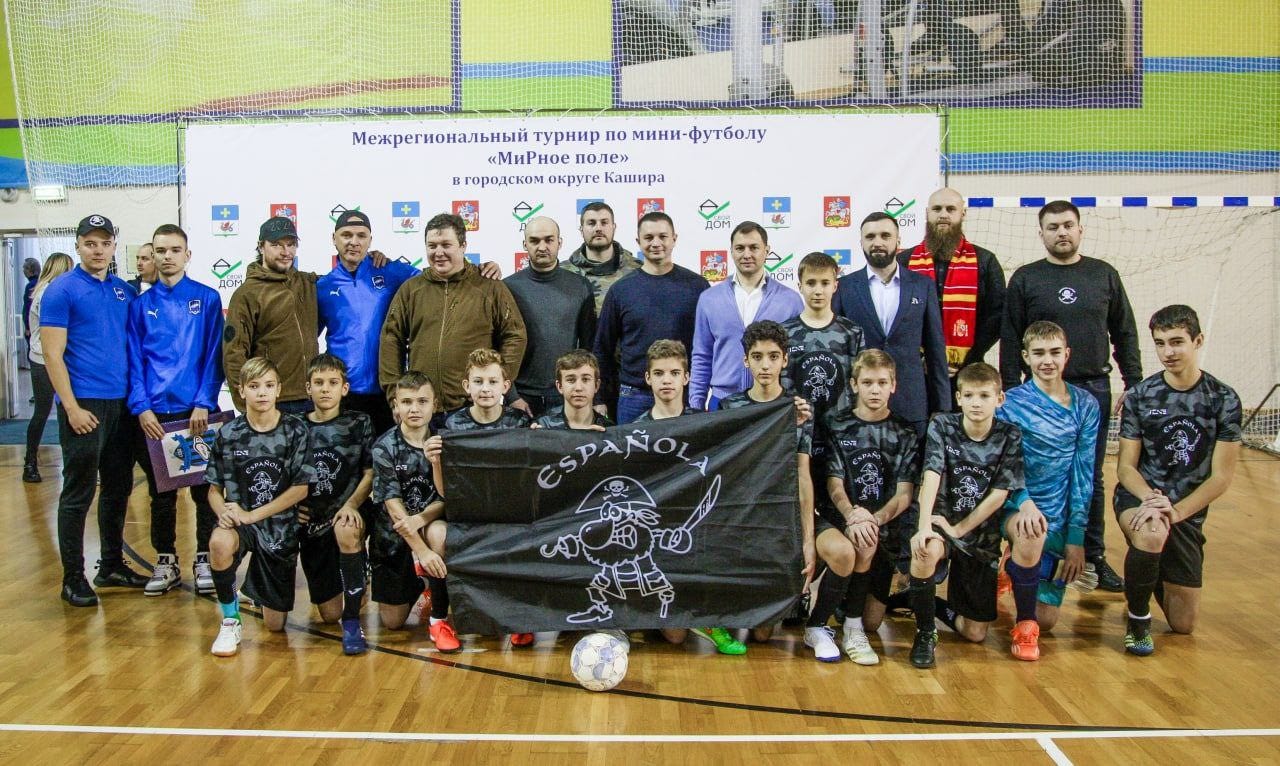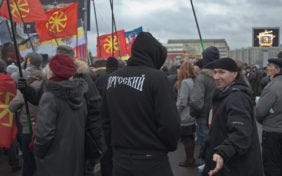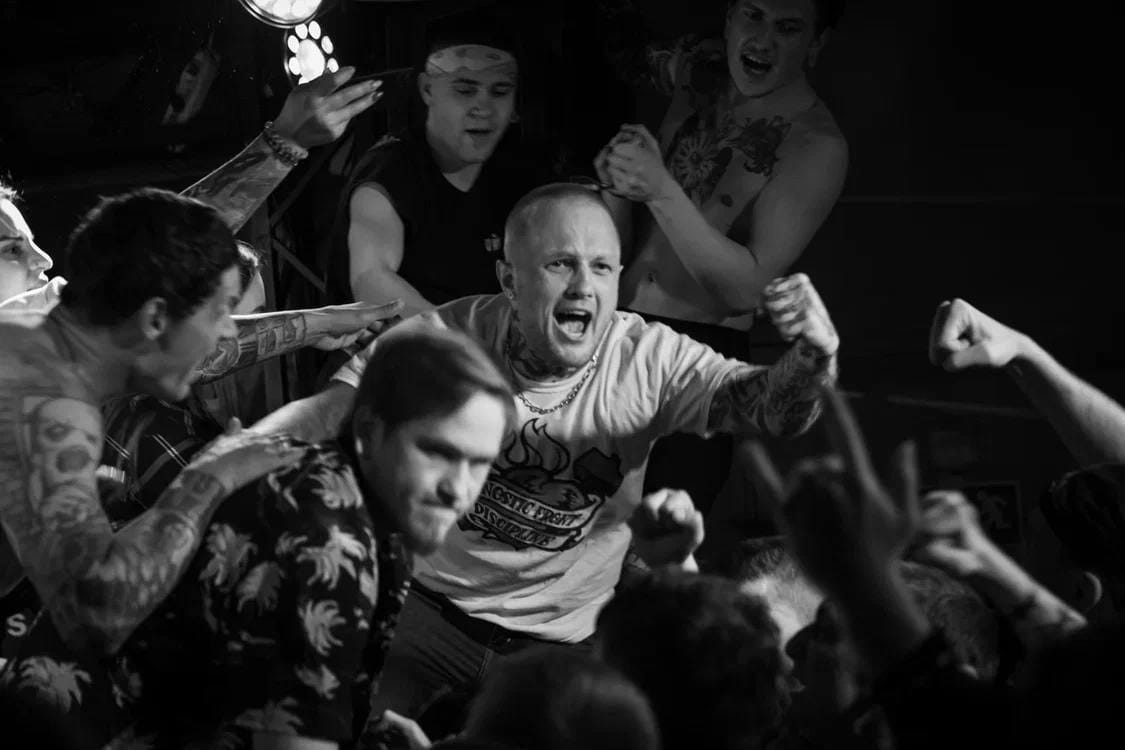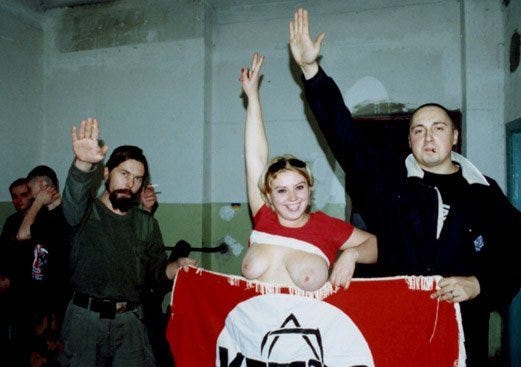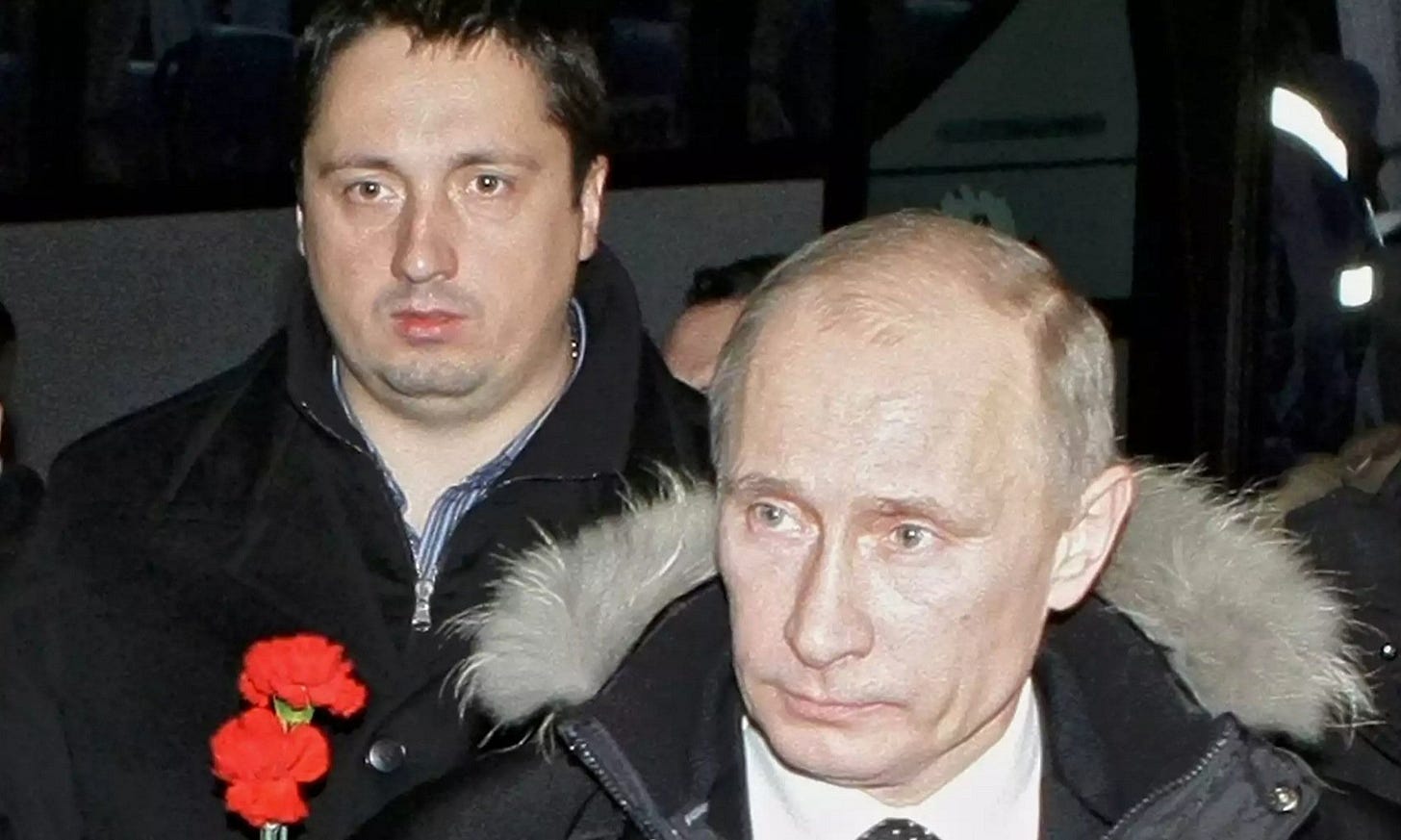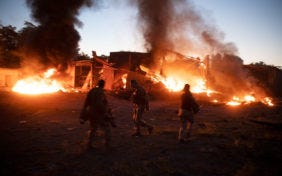Mar 18: Cherta Media, War fans: how football hooligans fight in Ukraine and how Vladislav Surkov and United Russia are connected with it
As published on the Cherta Media website on March 14, 2023
War fans: how football hooligans fight in Ukraine and how Vladislav Surkov and United Russia are connected with it, Cherta Media
“Get in touch. Don’t knead your boobs, ”this is how the Russian volunteer corps, which became famous after the events in the Bryansk region, was called to “scoring” the fighters of the Russian Espanyol detachment. There are fighting football fans with years of experience in fights and far-right, often overtly Nazi views. Despite such beliefs of the “denazifiers” from Espanyola, they are directly supported by the United Russia deputy, and the detachment commander is in an organization associated with Vladislav Surkov. "The Line" tells the story of a squad of football hooligans, which in a year has become one of the most media units of the NWO forces.
"Love in Russian"
“I am a Russian nationalist and I am not ashamed of it. Nationalism is made up of love for one's nation, country, this is a wonderful feeling. Therefore, my main goal in the NWO is the fight against Russophobia, which flourishes in the West and in Ukraine with the help of the West,” says Vyacheslav Subbotin, 36, with the call sign Vykhodnoy. He calls himself not only a nationalist, but also a fan of the CSKA football club.
The photographs on VKontakte show that Vyacheslav's back, arms and neck are almost completely filled with tattoos. On the left arm is a symbol that looks like a rounded swastika, on the chest is a cross reminiscent of the military order awarded in Nazi Germany before 1945, and on the left shoulder is a spider web, which is popular among skinheads and nationalists.
For more than four months, Subbotin has been serving in the Española (“Hispaniola”) division, which previously positioned itself as a squad of football fans, but at the end of February 2023 announced a change in status. Now they call themselves a private military company- PMC Española.
According to Subbotin, the fan movement was an integral part of his life for sixteen years. He participated in street clashes, riots, driving fights "at the most serious level, among the most serious teams."
“It was an amazing chapter of my life,” the man recalls. “The stadium has always been a piece of freedom for young people who could come there, express their point of view, throw out the accumulated negative energy.”
After 2016, Vyacheslav moved away from the near-football party, partly due to the close attention of the E Center and the introduction of Fan ID: “I think the secret services began to follow us more closely precisely because a lot of fan groups participated in the Maidan in 2014, and they overthrew the government. But we never bothered anyone. All fights have recently moved into the woods. At the stadium - only support for the team, pyrotechnic show, performance. Without it, football simply cannot exist.”
According to Subbotin, before the war he worked as a regional manager of a large company, where he was engaged in servicing the engineering systems of a chain of stores. In the GetContact application, Vyacheslav's name is most often mentioned in connection with the H&M store. According to him, he never dreamed of a military career, although there are many military men in the family: his father is a lieutenant colonel, his great-grandfather died under the Kursk salient; Vyacheslav himself served in the army.
In his youth, Subbotin says, he was “very worried” that there would not be a global military conflict in his lifetime and that he would not be able to prove himself as a man, “to reveal all his best qualities.” He is often photographed in military uniform and gives interviews in front of the black-yellow-white flag and coat of arms of the Russian Empire.
When asked why this flag regularly flashes in his social networks, Vyacheslav replies that he loves it very much as part of the history of his country, but clarifies that “at the moment” he sees the same flag as the ideal one, but with a kolovrat (eight-ray swastika - “ Devil » ) in the middle.
“[Such a flag symbolizes] the union of the pagan and the Christian. For the Russian people, this is a banner that should light the way. Christians, pagans, Spartak fans , CSKA fans must come together to build a greater Russia. "
Kolovrat is mentioned in the Federal List of Extremist Materials, and its demonstration is equated with propaganda of Nazi or extremist symbols and is punishable by an administrative fine or arrest. But Subbotin does not see anything wrong with the Kolovrat, as well as with the swastika, since, in his opinion, this is an Old Slavonic symbol and many military personnel in the DPR use it.
“It’s normal here,” Vyacheslav explains. “A lot of fighters in the DPR wear pagan symbols, including Kolovrat, Thor’s hammer, all kinds of Old Slavic runes, solstice.”
Vyacheslav also mentions that the swastika was used in Russia even before Nazi Germany. As an example, he cites a 250-ruble note issued by the Provisional Government. Behind the image of a double-headed eagle on a bill, you can really see a symbol that looks like a swastika.
Does this mean that the Russian Empire often used the swastika in its symbolism? This image appeared there quite by accident and has nothing to do with the ancient Slavic traditions. The Provisional Government simply did not have the resources to issue new money, so they took as a basis the clichés developed under the tsar for printing banknotes by order of the Mongolian National Bank. In Mongolia, there is indeed a “khas tamga” symbol, reminiscent of a swastika. So, Mongolian money came into use in Russia for several years.
Subbotin keeps returning to Russian history. According to him, the main mistake of communism, due to which, in particular, the modern war began, was the definition of the borders of Ukraine, to which "a lot of regions" were given.
“If we plunge into history, then Kharkiv, Odessa, Luhansk, Donetsk were founded and built by the Russian Empire. Therefore, they will speak Russian there, live in Russian and love in Russian, ”Subbotin is sure.
"Peculiar", but "completely not bloodthirsty"
The creation of a separate military detachment of Espanyol football fans fighting against Ukraine began to be actively discussed in the fall of 2022, although it was formed back in the spring. So, in early September , military commander Alexander Sladkov wrote that some of the fighters had “more than a hundred trips to mass fistfights” for their souls, but at the same time they were “completely not bloodthirsty” in everyday life.
Espanyola was formed on the basis of the Vostok brigade, created in 2014 by Oleksandr Khodakovsky, the former head of the Alpha special forces of the Security Service of Ukraine (SBU) in the Donetsk region, who defected to the separatists.
Khodakovsky himself, in his telegram channel, calls the Espanyola fighters volunteers “from a very peculiar environment,” but urges not to judge them strictly: “Point your finger at any of them in a peaceful setting, at his small scars from other people’s teeth on the knuckles and chipped from other people's blows to one's own teeth - as soon as an opinion is formed ... In principle, this will be the correct opinion <...> But this is when it comes to peaceful life. Perhaps these are born warriors, who are cramped in a peaceful shell ”(the spelling and punctuation of the author are preserved).
In the film published by Readovka, the commander of the Espanyola says that 150 people serve in the detachment. At the end of February, when the unit declared itself a PMC, a recruitment of new fighters was announced on a competitive basis. As they say in their telegram channel, “the top hooligan, fierce scumbags, just clear guys” have a chance to get to them.
"Don't get invited anywhere else"
The head of Espanyol is 42-year-old Stanislav Orlov, the call sign Spaniard is a fan of CSKA and a member of Russia's oldest "firm" (in football slang, a "firm" is a group of radical fans of a club - "Devil") Red - Blue Warriors.
Orlov served in the Airborne Forces. In an interview with the Fanzone program in 2012, he said that he took part in the Chechen campaign in 1999. According to former sports journalist and official Andrei Malosolov, Spaniard participated in the annexation of Crimea in 2014, and then went to the Donbass, where he led the Skull and Bones reconnaissance unit, which fought in Gorlovka and Debaltseve.
Hispaniola's symbol is a "dead head", a skull with crossbones and a circular inscription "Tea for the resurrection of the dead and the life of the next century. Amen" on a black background. The Spaniard himself in an interview said that this was “not some kind of piracy or a German totenkopf”, but the banner of the Russian general Yakov Baklanov, who participated in the Caucasian War and became famous for the destruction of many mountain settlements.
“In the Russian army, in addition to the “ Baklanovites ” , it was worn by the St. That's why I chose this symbol for my unit. And he recruited the most fierce [fighters], who became real pros. From my own experience, I can say that in combat situations, sometimes the most inveterate hooligans and in the past losers show themselves much better than standard people, ” said the Spaniard.
On the website of the Peacemaker Center, Orlov is listed as a “Russian mercenary” and a member of the Union of Donbass Volunteers (UDV), a public organization that united Russians who fought in the Donbass. Among the goals of the SDV were declared medical and social assistance to Donbass volunteers and their families. In 2015, the union was headed by the former prime minister of the self-proclaimed DPR, Alexander Boroday. In the telegram channel of the union, Stanislav Orlov is called “our comrade-in-arms.”
In 2017, the international investigative group InformNapalm published an article about the connection between the SDD and a former assistant to Vladimir Putin, one of the ideologists of the "Russian world" Vladislav Surkov. According to investigators, Surkov participated in the creation of the organization in order to "renew and strengthen his influence not only in the Donbass, but also in other regions and areas related to the sphere of national security of the Russian Federation."
In 2019, the current military correspondent and propagandist Semyon Pegov reported on his Telegram channel WarGonzo that Surkov attended the closed part of the Fifth Congress of the SDD in Moscow, where he assured that "no one is going to ' merge the Donbass ' ." In the photo from this meeting, next to him and the head of the Crimea, Sergei Aksyonov, Stanislav "Spaniard" Orlov is captured.
In March 2020, after his resignation from the position of presidential aide, Surkov officially attended the UDS conference as one of the four members of the presidium, where he stated that he “is not invited anywhere else, so it is doubly pleasant to be invited here.” In April 2022, State Duma deputy Ilya Ponomarev announced that Vladislav Surkov had been under house arrest in the case of embezzlement in Donbass since 2014. However, this information has not been officially confirmed .
Surkov himself did not comment on the full-scale war in Ukraine for almost a year. Only on February 16, 2023, he gave a very short interview , in which he answered four questions in monosyllables (“yes, yes, no, yes”), in particular, he said that he did not count on the implementation of the Minsk agreements he developed.
InformNapalm claims that members of the SDD participated in the preparation of the coup d'état in Montenegro in 2016. Including on September 30, according to investigators, Stanislav Orlov arrived in Montenegro, "which Surkov could not have been unaware of."
The coup, according to the Montenegrin authorities, was to take place on October 16, 2016 - the day of the parliamentary elections. Two Russians, Vladimir Popov and Eduard Shishmakov, were also found guilty of preparing it . According to the Montenegrin prosecutor's office, they organized an assassination attempt on the then Prime Minister Milo Djukanovic (later became president) in order to prevent Montenegro from joining NATO. Investigators from Bellingcat and The Insider found out that the sentenced Russians are employees of the GRU.
At Espanyol, The Line stated that the Spaniard was never affiliated with any organization other than the Red-Blue Warriors. Personal contact with the Spaniard "Dash" failed.
“Even those who were “against” became “for”
Until 2014, there were quite close ties between Russian and Ukrainian football fans - for example, in 2012, right-wing skinhead and football fan from the Russian Federation Denis Nikitin, who now heads the Russian Volunteer Corps, held a mixed fight tournament in Ukraine together with the SvaStone brand. But after the events on the Maidan, many Russian fans turned away from their Ukrainian "colleagues". In a conversation with the “Dash”, the representative of Espanyola, political officer with the call sign “Cross”noted that it all started "with their, Ukrainian, show-off and arrogance on the wave of the Maidan."
“Like we are such fiery revolutionaries here. They dropped the oppression, and as you were sitting " under the heel of the system , " you are sitting, - the man recalls. — It was the first swallow. Then Crimea, then Donbass. And it’s as if we are all to blame for this – and who supported and who did not support [the annexation of Crimea].”
According to him, in the first days after February 24, 2022, many of the near-football environment perceived Russia's actions "if not with hostility, then they certainly did not strongly approve." In addition, as Krest notes, Russian propaganda did not give any explanations, “hiding the monstrous sacrifices on our part, passing everything off as fiery victories.” However, their views soon changed under the influence of Ukrainian propaganda.
“From all the irons, from all points of the globe, it rained down: “ Russians die! “ Cross recalls. - Here everyone somehow decided: “ Well, no, it’s better somehow the other way around . ” The war went not for the government, not for the system already, but for the Motherland, for the life and future of their own children, for their property and land. And even those who were “ against ” in previous years quickly became “ for ” .
Krest does not deny that there are many fans from Ukraine just like them, however, he believes that in nine years “they have lost their humanity comprehensively”: “They [Ukrainians] there are stuffed head to toe with various horned Baphomets medieval names of the devil, the symbol of Satanism - "Dash" ), in our country the faces of the saints are hung in the arrangements. They even behave with their own population as occupiers and non-humans, for which there is a lot of evidence. They mock the prisoner, having lost all human appearance, competing in sadism. Although we are rather ruthless, we are not saints, yes, but we are not sadists either.
At the end of December, Channel One host Maryana Naumova, who filmed a story about Espanyola at their base, posted on her Telegram channel a photo of the headboard, on which the detachment members pasted stickers of their companies. In the photo you can see the slogans "Kill everyone, take everything away", "Forward, hussars, fuck and cut." All this is adjacent to the SS emblem on the sticker of the CSKA fan company Fearless and images of girls giving blowjobs.
Neo-Nazis and "successes in denazification"
In early March, Espanyola announced that its ranks were replenished by an "authoritative in various circles" football hooligan nicknamed "Pitbull" (real name Mikhail Turkanov) from the "Coalition" - the company "Zenith". He headed the ZU units (anti-aircraft installations - "Devil" ).
Mikhail Turkanov was actively discussed in the media a month ago, when the military-patriotic community of Cossacks "North Slavic Community" announced that he had been awarded the Order of Courage for participating in the war in Ukraine. Then investigative journalist Andrei Zakharov, citing data from the Ministry of Internal Affairs , reported that Turkanov's body had tattoos in the form of a swastika, a Celtic cross, the number 14 and two eights, and Kolovrat.
Turkanov was an MMA fighter and trainer who went to jail for extortion and was fined in 2019 for publicly displaying Nazi symbols. At the same time, like another Espanyola fighter, Vyacheslav Subbotin, Pitbull stated that the swastika was depicted on the banknotes of the Provisional Government and that the use of the symbol by Hitler "means nothing."
Officially, this award was not reported anywhere to Turkanov. Ukrainian journalist Denis Kazansky ironically remarked that Turkanov received the Order of Courage for "success in denazification".
Businessman, official and propagandist
Espanyola is not only military, but also civilians who are engaged in providing volunteers. In the film published by Readovka, Ilya Khanin and Aleksey Trifonov call themselves the main representatives of the "humanitarian wing" of Espanyola.
Khanin says in the film that he began to communicate with the guys from Espanyola back in 2014, when his older brother, “a volunteer and director of a charitable foundation,” came to Gorlovka and built a school there.
According to SPARK, a person with the same name and year of birth ( Ilya Aleksandrovich Khanin) is the general director of the construction company Sfera-Group LLC. The company's website states that one of its partners is Gazprom. In addition, Khanin heads the Svoi Dom charitable foundation, created, according to SPARK, by Nikolai Aleksandrovich Khanin, the current head of Kashira near Moscow and a United Russia deputy .
The website of the Public Chamber of the Moscow Region reports that in 2015 Nikolai Khanin organized a humanitarian action to restore secondary school No. 52 in Gorlovka, and also held various actions to popularize sports in the DPR and competitions among military-patriotic clubs in Moscow, the Moscow region and the DPR.
At the end of December 2022, Nikolai Khanin told in his telegram channel that a children's football tournament had started in his district in support of volunteers fighting in Ukraine, in the opening of which representatives of Espanyola and the "Wagner group " took part . In general photographs, you can really see people similar to Ilya Khanin and Alexei Trifonov.
The tournament was attended by a children's football team called Espanyola. Its participants are dressed in sports uniforms stylized as dark camouflage, the symbol of the team is a pirate with a skull and crossbones on his hat.
Most often, Andrey Malosolov, a propagandist, a former sports journalist and official, a fan of CSKA, who is known for a racist scandal, talks about Espanyol in his social networks and collects money to buy what they need . At the end of January of this year, Malosolov announced the creation of a second fan detachment - the Moscow battalion based on the 106th Airborne Division. According to Malosolov, the battalion consists not only of Moscow representatives of near-football, but also men from the regions of Russia. Now "Moskva" is undergoing combat coordination and will go to the front line closer to spring.
"Firms" and the Third Reich
The movement of football fans appeared in the USSR in the 1970s, when fans of Soviet football began to travel to away matches of their teams. But the new subculture for the country quickly attracted the attention of the KGB. It was impossible to create firms openly, says Alexander Verkhovsky, director of the Sova Information and Analytical Center.
A full-fledged fan movement began to develop in the second half of the 1990s. The first "firms" were Red-Blue Warriors from CSKA and Flint's Crew from Spartak. RBW's birthday is May 22, 1994, when the red and blue RBW banner appeared at the CSKA-Spartak match for the first time in the history of the Russian football movement. Later they came up with the famous emblem of the RBW - the skull of the SS-Totenkopf ( the emblem of the third SS Panzer Division in the Third Reich), framed by a Celtic cross (among neo-Nazis - one of the symbols of "superiority of the white race").
Researchers from the Higher School of Economics in their work “The Movement of Football Fans:
Structure and Collective Identities” identify four subgroups of participants in the football community: near-football players are the most active and aggressive members of the fan community who “defend the honor of the club” outside the stadium due to physical strength, that is, they participate in clashes and mass fights with fans of other clubs; ultras are also quite aggressive, but are more involved in supporting the team at the stadium - organize pyrotechnic shows, performances, make banners; football fans (hooligans) - are less aggressive, usually their support for the team does not go beyond the stadium or fan bars; fans ("kuzmichi") - the oldest, least aggressive and least involved in fan practices subgroup.
“The ideological aura is an explanation that a person does not just go to fight”
It is generally accepted that right-wing, nationalist political views are popular among football fans. However, as Alexander Verkhovsky notes, initially the fan movement was not ideological.
“Indeed, politicization towards ultra-right ideas overtook any other,” says Verkhovsky. - But in general, among the fans you could meet anyone. For them, the fan identity was more important than the political one." The New Times wrote in 2011 that, indeed, the stands at the stadiums were then occupied not only by “right-wing” fans, but also by “left-wing” anti-fascist fans opposing them.
Nikolai Mitrokhin, a historian and associate researcher at the Research Center for Eastern European Studies at the University of Bremen, also believes that the fan movement is based, first of all, on the desire of young people to assert themselves through force, and not on political ideology.
“The phenomenon of male brotherhoods, which take on different forms, exists in almost all cultures,” says Mitrokhin. - The fan movement offers people with an excessive degree of aggressiveness a kind of outlet within the framework of youth organizations aimed at learning how to fight. An ideological aura arises around this as an explanation that a person does not just go to fight, but for some just cause. A just cause can be politically ultra-right, or it can be ultra-left.”
Nevertheless, Verkhovsky notes, the fans' propensity for violence and their xenophobia made the movement a "natural reservoir" from which far-right groups could recruit their supporters.
So, for example, Spartak fans openly used the chant " White power! " " , and in the cult song of the near-football group CWT "Fight Club" were the words : "This is our fight club. They respect whites there, they hate khachis.”
“At the turn of the 90s and zero, it was very noticeable that neo-Nazi groups, not all, but almost all, consisted entirely of fans. But at the same time, it cannot be said that all the fans were neo-Nazis,” Verkhovsky notes.
According to Mitrokhin, football fans generally share the ideas of Russian nationalism (for the white race, against blacks), but their goals and methods differ from those used by the far right:
“Firstly, ultra-right political characters always strive to create some kind of criminal case (to kill someone), and secondly, often their opponents are representatives of the authorities, public organizations, journalists, and political competitors. Third, they carry knives and kill. Fans, on the other hand, prefer to use their fists, so beatings on their part are common, and killings are rare.
In the early 2000s, there were many attacks on people of non-Slavic appearance by football fans and Nazi skinheads, in particular with the use of edged weapons. But the fans got into the criminal chronicle even without the participation of Nazi skinheads or neo-fascists. So, for example, on March 13, 2004, after the Zenit-Rotor match in St. Petersburg, a group of fans attacked three Syrian citizens, one of them, a 22-year-old student, was pushed under a train, as a result he died. 21-year-old fan Valentin Bulanov was found guilty of murder .
"Hand Patriots"
The authorities have repeatedly tried to "tame" the fan movement, to make them "tame patriots," says Mitrokhin, including "to beat the faces of the opposition on the streets."
One of the first attempts to bring fans closer to him was made by Vladimir Zhirinovsky. He first met them in 1998. Among those present was one of the leaders of the Dynamo fan movement, Alexander Shprygin, who later became an assistant to Zhirinovsky's son, LDPR deputy Igor Lebedev. At the same time, in the same year, as Novaya Gazeta wrote , on the cover of one of the fanzines (the magazine for fans - "Devil" ), a collage was placed on which Shprygin, embracing Adolf Hitler, raised his hand in a Nazi salute. There is another photo where Shprygin "zigues" with the leader of the metal corrosion group, popular among the ultra-right, Sergei "Spider" Troitsky.
The Liberal Democratic Party provided fans with free buses and trains for trips, financed the publication of books and magazines. In response, as Shprygin recalled in an interview with Sports.ru, Zhirinovsky only asked to be remembered when they would vote in the elections. True, sometimes, says Shprygin, party representatives asked fans to take part in events as a guard for a politician and even participants in political actions.
Later, in the 2000s, the fans collaborated with the Nashi patriotic movement. Shprygin claimed that it was the fans who guarded the Nashi congress in the camp on Lake Seliger in the Tver region, where Vladimir Putin regularly visited.
In 2007, at the initiative of the Russian Football Union (RFU), the All-Russian Association of Fans (VOB) was created, co-founded by Shprygin and Andrey Malosolov. The VOB essentially served as a fan union. More than ten years later, in an interview with the British The Guardian, Shprygin bluntly stated that the organization was created by order of the FSB. Although earlier in a conversation with Sports.ru he assured that the VOB "cannot be considered politics at all." Kommersant wrote that the VOB was called "the personal army of Mutko", then the head of the RFU and the Minister of Sports, because "he patronized the VOB, trusting, for example, to distribute tickets for matches of the Russian national team."
In 2010, Yegor Sviridov, a fan of Spartak, was killed in Moscow by natives of the Caucasus. In response to this, on December 11 , according to various estimates, from five to fifty thousand people came to Manezhnaya Square . They shouted nationalistic slogans, blew up firecrackers and beat people of non-Slavic appearance. Malosolov and Shprygin assure that there was a minority among the gathered fans, but mostly nationalists, nazbols and other ultra-rightists gathered.
Nevertheless, after the Manezhka, fans expected reprisals. But the unexpected happened - Vladimir Putin wanted to meet with them. At the meeting, he urged fan clubs to maintain their independence and not allow themselves to be manipulated by extremists and radicals.
Another meeting with Putin was in 2012 as a presidential candidate, including the organization of the 2018 World Cup.
According to Shprygin, after this meeting, commercial offers from Aeroflot, Russian Railways and other large companies literally rained down on the VOB.
However, in 2016, friendly flirting with the authorities ended after a mass brawl between Russian and British fans in Marseille at Euro 2016, in which several dozen people were injured . Shprygin also participated in this, who had to be deported from France twice. After that, a search was conducted in the office of the VOB , and soon they were expelled from the Russian Football Union (RFU). The official reason is "violation of ethical standards." In an interview with Sports.ru, Shprygin said that after that he was "not invited anywhere."
As The Guardian wrote , after the fight in Marseille, the Kremlin realized that these same people could embarrass the country if mass violence broke out at the 2018 World Cup. Then Putin held a meeting with the leaders of law enforcement agencies, and then publicly stressed "the need to study the French experience."
"Sit on your ass"
Since 2017, Fan ID has been introduced in Russia. It is not easy for fans who were previously seen in hooligan actions to obtain a fan ID. Many even boycott it, considering it a humiliating demand. However, the pressure of the authorities on the fans did not stop there. According to Shprygin, any activity of the fans is now under the scrutiny of the security forces, criminal cases are being actively opened against them and “nightmares” are being organized in every possible way - they are raiding, they come with searches at home, at work, to their parents. Because of this, the fans "sat on their asses, became accommodating and meek."
This is also reflected in the symbolism. It became impossible to openly display signs similar to Nazi signs on banners or clothing, as this became punishable by law.
“But there are things that are not punishable,” notes Alexander Verkhovsky. — For example, you can write on banners with letters that resemble runes. It would seem, runes and runes. But in the environment everyone understands that this is a reference not to Scandinavian antiquities, but to the traditions of the SS. However, it's impossible to complain."
Some fans believe that this is how the country was preparing for the 2018 World Cup. Another part notes that the authorities stepped up repression against fans after the events on the Maidan in 2014, where Ukrainian football hooligans actively participated . In any case, such measures have generated great dissatisfaction among the fans in relation to the authorities.
"I fight just because I fight"
Nikolai Mitrokhin believes that it was not possible to completely tame the fans of power. But participation in the war is another matter, the expert believes.
“Both in Russia, and in Ukraine, and in other states there is a layer of young men who would like to do something that, in their understanding, is “ real ” , masculine. For example, to really fight. And suddenly they have such an opportunity to show themselves, they also promise a lot of money for this. Therefore, moral arguments do not work here, ”says Mitrokhin.
A similar situation occurred on the Ukrainian side. In 2014, he recalls, the Ukrainian fan movement quickly mobilized, went to war and became one of the most valuable parts of the army, in particular the volunteer (at that time) Azov battalion .
“By and large, the fight on both sides is largely neo-Nazis – right-wing extremist young men who worked closely with each other until 2014. This is one social cultural environment. What is the big difference between “ Spartak ” and “ Dynamo ” ? But people beat each other. So here. As Porthos said in The Three Musketeers , “ I fight simply because I fight , ” Mitrokhin says.
Tulips for the deceased husband
Fans have already begun to give their lives for this fight. On February 14, Espanyola's social networks reported the death of Andrey Rakhov (Arnie), call sign "Firefighter", also a veteran of near-football, a representative of "Music Hall" - the company "Zenith", who in civilian life worked as a firefighter.
As the publication “North. Realities”, Rakhov was blown up by a mine near Ugledar together with his colleague Andrei Kovalishin, who, unlike Rakhov, did not even have time to sign a contract.
On October 30 last year, it became known about the death of another of the Espanyola participants - Maxim Shmanin, call sign "Placart". He is referred to as a "veteran" of the Red-Blue Warriors. Died during shelling near Donetsk as a result of a shrapnel wound to the head. He was posthumously awarded the medal "For Merit in Service in Special Conditions" I degree from the Ministry of Internal Affairs of the unrecognized DPR.
Now Andrei Malosolov is collecting money to help his family - his wife and two children. He visited the widow in honor of March 8, gave her tulips and 178 thousand rubles for her dead husband, and received from her beer "Legend of Donbass".




